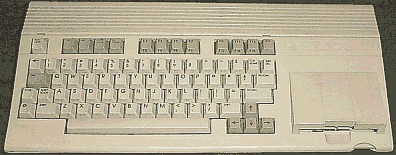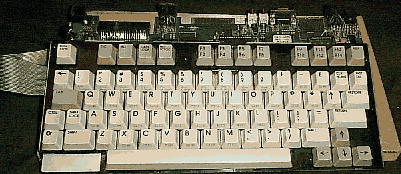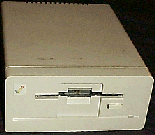Commodore 64DX / Commodore 65
 In 1989, Commodore began an endeavor which was way overdue. The creation of a near Amiga-quality computer that is 8-bit in spirit, compatible with the popular Commodore 64 (through an emulation mode), and containing a built in disk drive. Assuming that the price range could have been set below $499, and assuming that this project had been done back in 1985 instead of 1989-1991, I believe this would have been an big seller for Commodore, and would have breathed life into them which would have extended CBM beyond 1994.
In 1989, Commodore began an endeavor which was way overdue. The creation of a near Amiga-quality computer that is 8-bit in spirit, compatible with the popular Commodore 64 (through an emulation mode), and containing a built in disk drive. Assuming that the price range could have been set below $499, and assuming that this project had been done back in 1985 instead of 1989-1991, I believe this would have been an big seller for Commodore, and would have breathed life into them which would have extended CBM beyond 1994.
As it was, the design of the Commodore 65 started in 1989, and the project was scrapped a few years later. A few prototypes leaked out in 1994 when Commodore liquidated, which is why they are known of at all. There are those who say that only about 200 exist. Others say the number is closer to 1000. I happen to hold with the former, since both of my models have serial numbers below 200, as does every existing model I have heard of.
The Commodore 65 is truly remarkable. Taking the latest in video technology, combining it with the best from the 8-bit years, and putting it all in an attractive, very Commodore-like, package. If you'd like to see what it looks like underneath the hood, click here.
 From left to right, you'll see here the 1565 external drive port, composite video DIN, future 3-4 switch, future RF port, RGBI video port, left audio, right audio, CBM user port, CBM serial port, C65 expansion port. On the left side of the machine are the power socket, on-switch, 2 joystick ports, and a reset switch. Underneath the computer is an Amiga-500 like belly port for expanded memory. Near that same belly port, an FCC sticker reports that this computer has a serial number of 000047.
From left to right, you'll see here the 1565 external drive port, composite video DIN, future 3-4 switch, future RF port, RGBI video port, left audio, right audio, CBM user port, CBM serial port, C65 expansion port. On the left side of the machine are the power socket, on-switch, 2 joystick ports, and a reset switch. Underneath the computer is an Amiga-500 like belly port for expanded memory. Near that same belly port, an FCC sticker reports that this computer has a serial number of 000047.
 Here is my unique offering, however. Coming straight out of the Commodore shop, this "workbench" C65 is nothing but a block of wood upon which is mounted an early version of the C65 motherboard. Velcroed to a pair of metal plates is a keyboard made by Mitsumi back in 1989. Believe it or not, besides lacking the internal drive or the chips to run one, this system works just fine. In some ways, it works a little better than my full prototype.Here you can see the workbench c65 with the keyboard set aside. Notice the missing chips on the right hand side. You can get a look of that by clicking here. Also notice the wiring work near the left-top of the board. I have no idea what the engineer was doing when he was adding those wires, though an unmounted chip is connected to it. Get a closeup of the new wiring by clicking here. Lastly, along with this workbench computer, I received from the previous owner a C65 casing. The casing proclaims this machine to be serial number #000067, as you can see here, though I doubt the case is in any way associated with this motherboard. You can see this casing by clicking here .
Here is my unique offering, however. Coming straight out of the Commodore shop, this "workbench" C65 is nothing but a block of wood upon which is mounted an early version of the C65 motherboard. Velcroed to a pair of metal plates is a keyboard made by Mitsumi back in 1989. Believe it or not, besides lacking the internal drive or the chips to run one, this system works just fine. In some ways, it works a little better than my full prototype.Here you can see the workbench c65 with the keyboard set aside. Notice the missing chips on the right hand side. You can get a look of that by clicking here. Also notice the wiring work near the left-top of the board. I have no idea what the engineer was doing when he was adding those wires, though an unmounted chip is connected to it. Get a closeup of the new wiring by clicking here. Lastly, along with this workbench computer, I received from the previous owner a C65 casing. The casing proclaims this machine to be serial number #000067, as you can see here, though I doubt the case is in any way associated with this motherboard. You can see this casing by clicking here .
 The last interesting thing I received along with this computer was a disk drive! Although it appears to be an Amiga 1010, it most certainly is not. It's actually a 1581 inside a A1010 case. But why didn't the engineer just use a 1581? Who knows. Either way, this is certainly not the fabled 1565, which would have communicated with the c65 through its bus disk drive port instead of through the serial port like this drive does. The label on the bottom proclaims this to be DD disk drive #12, along with an FCC warning sticker. You can see this orange sticker by clicking here
The last interesting thing I received along with this computer was a disk drive! Although it appears to be an Amiga 1010, it most certainly is not. It's actually a 1581 inside a A1010 case. But why didn't the engineer just use a 1581? Who knows. Either way, this is certainly not the fabled 1565, which would have communicated with the c65 through its bus disk drive port instead of through the serial port like this drive does. The label on the bottom proclaims this to be DD disk drive #12, along with an FCC warning sticker. You can see this orange sticker by clicking here
You can see here what I mean. Grossly protruding from this case are a pair of standard CBM serial ports, the device number switch, power connector, and switch. Now take a close look at the full motherboard by clicking here. If you looked, you'll agree that a standard 1581 motherboard is mounted inside. Standard, except for the power connector that is: a 4-bin female din I've never seen before. The drive required its own power supply, which you can see by clicking here. The mechanism inside appeared to be for a standard Amiga 1010, which is also interesting.
| CPU |
CSG 4510
3.54 Mhz clock speed |
| RAM |
128 kilobytes, expandable to 8 megabytes |
| ROM |
C65 Kernal and BASIC 10.0
C64 emulation kernal and BASIC 2.0
C65 disk drive DOS |
| Video |
CSG 4569 "VIC-III"
6 Video modes
Resolutions from 320x200 to 1280X400
80 columns text
Pallette of 4096 colors. |
| Sound |
CSG 8580 "SID" (2X)
6 voice stereo synthesizer/digital sound capabilities |
| Ports |
CSG 4510
2 Joystick/Mouse ports
Round DIN CBM Serial port
Male edge-connector CBM 'USER' port
Round DIN CBM Monitor port
Power and reset switches
Round C65 bus drive port
Unimplemented RF video port
Round power DIN port
9-pin female RGBI video port
2 RCA audio ports
Belly ram expansion port
Female edge-connector C65 expansion port |
| Kyboard |
Full-sized 77 key QWERTY
12 programmable function keys
4 direction cursor-pad |
| Miscellaneous |
Built in 3.5" DD disk drive (1581 compatible)
Partially implemented Commodore 64 emulation |
Personal Note:
If this machine had a larger user base, I would seriously consider programming for it. It is THAT cool. The engineers model I got first back in 1997 from a lady in Florida. She also sent the spare case and drive with it. While my first production prototype came from a collector in California, the one I keep these days is from the George Page collection.